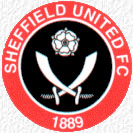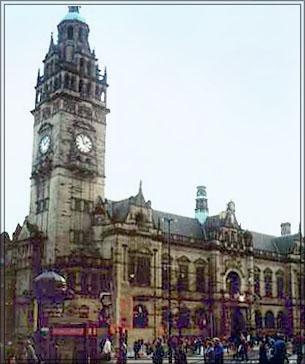Yorksview
| Sheffield and steel. The
two go together like fish and chips, Morecambe and Wise and love and marriage.
Not surprisingly Sheffield’s hugely successful ice hockey team calls itself
the Steelers. The manufacture of cutlery has taken place there since the
Middle Ages. The Cutlers’ Company of Hallamshire was founded in 1624 before
the Civil War. Crucible steel and Sheffield plate were invented here.
Expansion in the eighteenth and nineteenth centuries made Sheffield the
world’s foremost steel manufacturing centre based in the lower Don valley.
The invention of stainless steel in 1913 was a further boost. In the 1960s and
1970s much steel-based industry was lost as markets and technology changed.
Today more steel than ever is produced but by means which are far cleaner and
involve employing far fewer people. |
Town Hall |
The
wealth created by the steel industry and its high quality products made the
Victorian city one of great elegance. (There was of course extreme poverty for
many too and appalling slums). Many great Victorian and Edwardian civic and
industrial buildings remain but the Luftwaffe gave Sheffield one hell of a
hammering during the Second World War. What was built between the late 1940s
and 1970s, as usual, generally leaves a lot to be desired. Attempts are now
being made to disguise this post-war brutalism but in truth many of the
buildings need to and will come down.
Sheffield
is built on hills being on the edge of both the Peak District and the south
Pennines. It stands on the Don where it meets the Sheaf. It became a city in
1893 and has since swallowed up many villages. Sheffield people regard theirs
as Yorkshire’s first city but in truth Leeds is now Yorkshire’s regional
commercial centre.
Between the Town Hall and the Cathedral is Cutlers’ Hall, a magnificent building with a magnificent collection of silver therein. This is the Company of Cutlers' banqueting hall, one hundred feet long with marble walls, a huge dome and fine portraits of Victorian worthies.

Sheffield has two universities – Sheffield, and Hallam, formerly a polytechnic. Sheffield also, of course, has two football clubs – Sheffield Wednesday, so-called because, yes, you’ve guessed, they played on Wednesdays, and Sheffield United. Sheffield United are known as the Blades (steel again) and Wednesday are the Owls. Sheffield claims to have given the world football in Sheffield FC, an amateur club founded in 1857.

John
Betjeman liked Broomhill and described it as England’s finest suburb. It
became the smart middle-class area of Sheffield in the Victorian period. Like
Jesmond in Newcastle and Headingley in Leeds, it has since the Second World
War become student dominated and as a result buzzes with activity. There are
owner-managed shops selling everything from fresh flowers to second-hand
records. There are lively pubs like the Broomhill Tavern in Glossop Road.
Opposite it is a deli which I can recommend to anyone. There is a bookshop and
a proper ironmongers. I always feel that these make a place so much more
interesting than the uniform building societies, estate agents and
hairdressers.
jdb
(images supplied)

